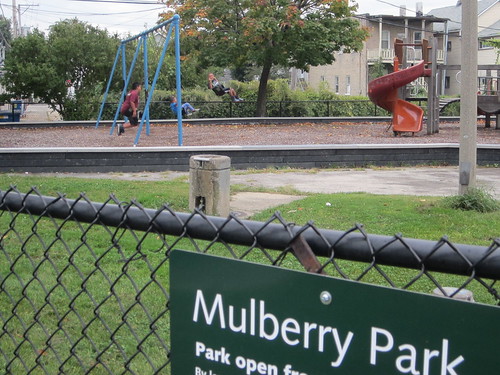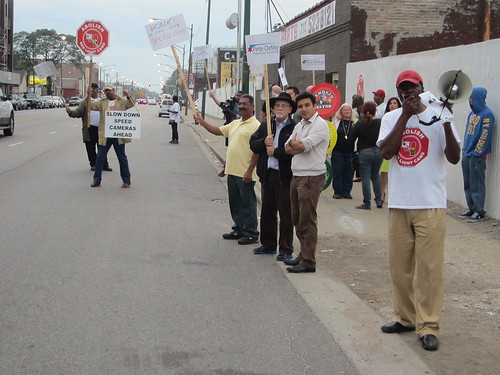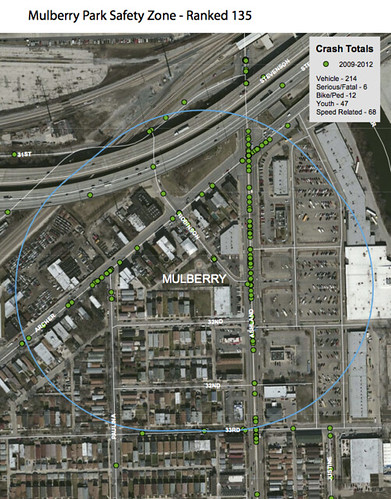If you can't beat 'em, join 'em. About a year ago, Citzens to Abolish Red Light Cameras collaborated with 12th Ward aldermanic challenger Pete DeMay on a protest against new speed cams on the 3200 block of South Archer in McKinley Park neighborhood, near the Mulberry Park green space. The demonstration was partly targeted at incumbent alderman George Cardenas, who voted in favor of Chicago’s speed camera ordinance. Cardenas won reelection last winter, and this morning he joined forces with CARLC to hold a second protest against the Mulberry cams.
In Chicago, speed cameras don’t require drivers to go anywhere near the speed limit. The city currently only issues tickets for violations of 10 mph or more over the posted limit, which is usually 30 mph. Studies show that while pedestrians struck at 30 mph usually survive, those stuck at 40 mph or higher almost always die.
Therefore, it would actually make sense to lower the 10 mph threshold but, due to pushback on the cams, it’s unlikely the city will do that anytime soon. Still, many local drivers have bristled at the notion that they should have to pay more attention to their speedometers.
The Mulberry speed cams are particularly controversial because the park is a relatively small green space that’s visible, but not conspicuous, from Archer. Therefore, CARLC has argued that the city installed the cameras in an effort to raise revenue, not improve safety.
However, since state law dictates that speed cams can only be installed within an eighth-mile of parks and schools and parks, it’s likely that the city’s main motivation for installing these cams was to address crashes on Archer and nearby Ashland Avenue. Mulberry Park’s safety zone, the one-eighth-mile buffer around a park or school, was in the top ten percent of Chicago safety zones for crashes, according to the Chicago Department of Transportation. Between 2009 and 2012, there were 214 crashes near the park, including six causing serious injury or death. In 68 of these collisions, speeding was a factor, and 47 of the crashes involved children.
While he was being targeted by the anti-cam crowd, Cardenas launched his own assault against Mulberry cams. He put up an online survey asking constituents whether the cameras should be relocated or removed. Unsurprisingly, since many of the the respondents were likely drivers who had been caught speeding, 65 percent said the cams should be eliminated. Emboldened, Cardenas proposed the novel idea of bulldozing the park, so that CDOT would be legally required to take down the cams.
After Chicago speed cameras are installed, there’s a 30-day introductory period when they only issue warnings, not tickets. The Mulberry cams went into the warning phase last year but never started issuing tickets. “In response to community concern, we reviewed the location – and the speed limit was increased from 25 to 30 MPH -- and then there was a park construction project [improvements to Mulberry] that intervened,” said CDOT spokesman Mike Claffey.
On Friday, the department announced that they would start a new 30-day warning phase today, and then begin issuing tickets from the cameras. Yesterday, Cardenas emailed constituents to announce this morning’s protest in partnership with the anti-cam activists.
“This camera is nothing more than an aggressive tactic to nickel and dime the taxpayers of this area,” Cardenas wrote. “These minor park investments are lipstick on a pig, the community knows this is a playlot that children do not use.” Funny, when I visited the park last year, I saw three young boys having fun on the swing set and jungle gym.
Cardenas added that 1,000 residents have signed a petition to have the Mulberry Park cams removed. “I will take any and all action necessary to fight City Hall and remove this camera immediately.”
There’s an odd disconnect among the folks who are fighting against the speed cams. When I stopped by last year’s Mulberry Park protest, I spoke to several CARLC members, and they all told me they believe 30 or 35 mph is a reasonable speed limit for city streets.

Moreover, most people who get ticketed by cams for speeding in Chicago safety zones don’t repeat the mistake. According to CDOT, speeding violations have dropped by an average of 53 percent within 90 days after cameras are turned on. 67 percent of drivers who were ticketed in a park zones did not rack up a second violation -- 81 percent in school zones.
So it’s interesting that Cardenas and the anti-cam crew are protesting cameras that won’t ticket anyone going less than 40 mph – a speed at which pedestrian crashes are almost always fatal. It’s obvious that the alderman is less interested in reducing the number of serious injuries or deaths within the park’s safety zone than scoring points with voters.





